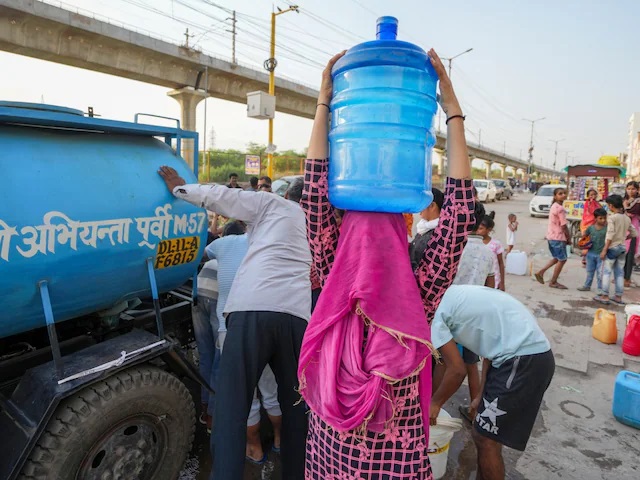
New Delhi- Moody’s Ratings today said India’s growing water shortage can disrupt farm and industry sectors and is detrimental to the credit health of the sovereign as rising food inflation and decline in income may spark social unrest.
It said decreases in water supply can disrupt agricultural production and industrial operations, resulting in inflation in food prices and hence can be detrimental to credit health of sectors that heavily consume water, such as coal power generators and steel-makers.
India’s fast economic growth, accompanied by rapid industrialisation and urbanisation, will reduce water availability in the world’s most populous country, it said.
Also, the water stress is worsening because of an acceleration of climate change, which is causing increasingly intense and frequent extreme climate events such as droughts, heat waves and floods.
India is facing a growing water shortage as water consumption increases amid rapid economic growth and increasingly frequent natural disasters due to climate change, Moody’s said in a report on environmental risk facing India.
“This is detrimental to the credit health of the sovereign, as well as sectors that heavily consume water, such as coal power generators and steel-makers. In the long term, investment in water management can mitigate risks from potential water shortages,” Moody’s Ratings said in the report.
The report comes amid a growing water crisis faced by residents in some parts of the national capital, which has led to protests and political conflict. Delhi Water Minister Atishi, who began her hunger strike on June 21 over the issue, was hospitalised on Tuesday morning after her health deteriorated.
“Decreases in water supply can disrupt agricultural production and industrial operations, resulting in inflation in food prices and declines in income for affected businesses and communities, while sparking social unrest. This in turn can exacerbate volatility in India’s growth and undermine the economy’s ability to withstand shocks,” Moody’s said.
Quoting Ministry of Water Resources data, Moody’s said India’s average annual water availability per capita is likely to drop to 1,367 cubic meters by 2031 from an already-low 1,486 cubic meters in 2021 A level below 1,700 cubic meters indicates water stress, with 1,000 cubic meters being the threshold for water scarcity, according to the ministry.
Moody’s said a heat wave in June 2024, with temperatures hitting 50 degrees Celsius in Dehli and the northern Indian States, strained water supply. Floods, one of the most common types of natural disasters in India, disrupt water infrastructure, which is insufficient to retain water from sudden large downpours.
Floods in northern India and Cyclone Biparjoy in Gujarat in 2023 caused economic losses of USD 1.2-1.8 billion and damage to infrastructure, according to an estimate by the State Bank of India, it said.
Monsoon rainfall is also lessening. The Indian Ocean warmed at a rate of 1.2 degrees Celsius per century during 1950-2020, and this will intensify to 1.7-3.8 degrees Celsius during 2020-2100, according to the Indian Institute of Tropical Meteorology.
The amount of rainfall has decreased, while droughts have become more severe and frequent. In 2023, monsoon rainfall in India was 6 per cent less than the average for 1971-2020, and the country had an unprecedented rain shortfall in August that year. More than 70 per cent of rainfall in India is concentrated in June-September each year, according to the Moody’s report.
In the past, disruptions to agricultural production and a rise in inflationary pressure have led to increases in food subsidies that have contributed to India’s fiscal deficits. Food subsidies were budgeted at 4.3 per cent of central government expenditure for the current fiscal year (2024-25), one of the largest items in the budget, the report said.
Coal power generators and steel-makers heavily depend on water for production and growing water shortages can disrupt their operations and hamper their revenue generation, eroding their credit strength, it said.
Moody’s said the Indian government is investing in water infrastructure and making a push for the development of renewable energy. At the same time, heavy industrial consumers of water are looking to improve the efficiency of their water use. These efforts can help reduce water management risks for both the sovereign and the companies in the long term.
“The sustainable finance market in India is small but developing fast. It can provide companies and regional governments with a critical avenue to raise funds. Some states facing severe water shortages have used the sustainable finance market to raise funds for investment in water management,” Moody’s said.
Moody’s said Industrialisation and urbanisation will lead to intensifying competition for water among businesses and residents. India has significant room for industrialisation and urbanisation. Industry’s share of India’s GDP was 25.7 per cent in 2022, smaller than a G-20 emerging market median of 32 per cent, according to the World Bank. Also, residents in urban areas accounted for only 36 per cent of the country’s total population in 2022, a ratio that is likely to grow given that the G-20 emerging market median is 76 per cent.
According to a World Bank report on February 2023, over the last decade, the multilateral lender has supported the Indian government’s efforts to bring clean drinking water to rural communities. A range of projects with a total financing of USD 1.2 billion have benefitted over 20 million people.
Follow this link to join our WhatsApp group: Join Now
Be Part of Quality Journalism |
Quality journalism takes a lot of time, money and hard work to produce and despite all the hardships we still do it. Our reporters and editors are working overtime in Kashmir and beyond to cover what you care about, break big stories, and expose injustices that can change lives. Today more people are reading Kashmir Observer than ever, but only a handful are paying while advertising revenues are falling fast. |
| ACT NOW |
| MONTHLY | Rs 100 | |
| YEARLY | Rs 1000 | |
| LIFETIME | Rs 10000 | |











